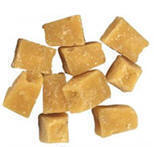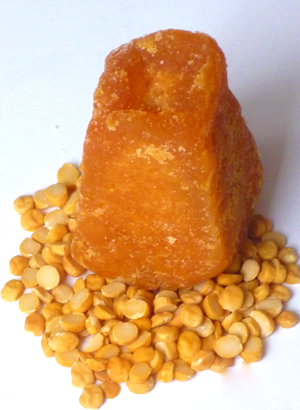 |
| Jaggery {Urdu (گڑ)} |
Jaggery is widely used as a sweetener.
Best variety and class of Jaggery is only cultivated and found in India. Jaggery is known for mesmerizing tastes; especially when it is Indian Jaggery! Indian Jaggery served by us is known for their highest quality and freshness that no other can assure. Well checked by international experts; our Indian Jaggery has been highly demanded in the global marketplace. We also offer you load of varieties for Jaggery so that you get plentiful options to choose. Our palm Jaggery is also very popular in the agro food industry. Also, at our place you get Jaggeries packaged and handled in safest ways. For giving in wondrous Jaggery to world, we are rated as one of the topnotch Jaggery exporters and suppliers in India. it is very rich in iron, which, a composite of hemoglobin prevents anemia. Jaggery is especially recommended for pregnant women. It is rich in magnesium, iron, & potassium. Magnesium strengthens the nervous system & potassium is vital to conserve the acid balance in the cells. Taj Agro Products, Jaggery is chemical free! It does not contain sulphur dioxide, lime, phosphoric acid, bleaching agents or any viscosity reducers that are used in making 'extra white jaggery' by most manufacturers.
Best variety and class of Jaggery is only cultivated and found in India. Jaggery is known for mesmerizing tastes; especially when it is Indian Jaggery! Indian Jaggery served by us is known for their highest quality and freshness that no other can assure. Well checked by international experts; our Indian Jaggery has been highly demanded in the global marketplace. We also offer you load of varieties for Jaggery so that you get plentiful options to choose. Our palm Jaggery is also very popular in the agro food industry. Also, at our place you get Jaggeries packaged and handled in safest ways. For giving in wondrous Jaggery to world, we are rated as one of the topnotch Jaggery exporters and suppliers in India. it is very rich in iron, which, a composite of hemoglobin prevents anemia. Jaggery is especially recommended for pregnant women. It is rich in magnesium, iron, & potassium. Magnesium strengthens the nervous system & potassium is vital to conserve the acid balance in the cells. Taj Agro Products, Jaggery is chemical free! It does not contain sulphur dioxide, lime, phosphoric acid, bleaching agents or any viscosity reducers that are used in making 'extra white jaggery' by most manufacturers.
Origins and production Jaggery is made of the products of both sugarcane and the palm tree. The sugar made from the sap of the date palm is both more prized and less commonly available outside of the regions where it is made. The sago palm and coconut palm are also now tapped for producing jaggery in South India, Pakistan, and Sri Lanka. All types of the sugar come in blocks or pastes of solidified concentrated sugar syrup heated to 200°C. Traditionally, the syrup is made by boiling raw sugarcane juice or palm sap in a large shallow round-bottom vessel. |
Uses
Jaggery is used as an ingredient in both sweet and savory dishes across Pakistan, India and Sri Lanka. For example, a pinch of jaggery is sometimes added to sambar, rasam, and other staples in India.
Jaggery is also added to lentil soups (dal) to add sweetness to balance the spicy, salty, and sour components, particularly in Gujarati cuisine called, add in cooking.
The Indian state of Maharashtra is the largest producer and consumer of jaggery. In Maharashtra, most vegetables curries and dals contain jaggery. Jaggery is specially used during Makar Sankranti for making sweetmeat called tilgul. Similarly, in Gujarat on Makara Sankranti, this preperation is made, and known as Tal na Ladu or Tal Sankli'. In rural Maharashtra, water and a piece of jaggery is given when someone arrives home from working under a hot sun. Kakvi, a byproduct from production of jaggery, is also used in rural Maharashtra as a sweetener. It contains many minerals not found in ordinary sugar and is considered beneficial to health by the traditional Ayurvedic medical system.
Jaggery is used as an ingredient in both sweet and savory dishes across Pakistan, India and Sri Lanka. For example, a pinch of jaggery is sometimes added to sambar, rasam, and other staples in India.

Jaggery is also added to lentil soups (dal) to add sweetness to balance the spicy, salty, and sour components, particularly in Gujarati cuisine called, add in cooking.
The Indian state of Maharashtra is the largest producer and consumer of jaggery. In Maharashtra, most vegetables curries and dals contain jaggery. Jaggery is specially used during Makar Sankranti for making sweetmeat called tilgul. Similarly, in Gujarat on Makara Sankranti, this preperation is made, and known as Tal na Ladu or Tal Sankli'. In rural Maharashtra, water and a piece of jaggery is given when someone arrives home from working under a hot sun. Kakvi, a byproduct from production of jaggery, is also used in rural Maharashtra as a sweetener. It contains many minerals not found in ordinary sugar and is considered beneficial to health by the traditional Ayurvedic medical system.
In addition, in the Indian state of Rajasthan, jaggery has a religious significance. Many of the festivals are incomplete without jaggery as it is offered to the deity during worship. Also, it is regularly consumed as a sweetener and is a part of many sweet delicacies such as gur ka chawal (lit. "jaggery rice"), a traditional Rajasthani dish.
In Gujarat famous laddus are made from wheat flour and jaggery, and also another recipe Puranpoli, which has its roots in Maharasthra, is also made using jaggery as sweetener. Also, jaggery is consider handy sweet, which is shared on any good occassion. On Engagement ceremonies jaggery is made into small particles and mixed with coriander seeds and distributed, hence in many Gujarati communities Engagement is commonly known as Gol-Dhana literally meaning Jaggery & Coriander seeds.
In Myanmar, jaggery is harvested from toddy palm syrup. In central Myanmar and around Bagan (Pagan), toddy syrup is collected solely for the purpose of making jaggery. The translucent white syrup is boiled until it becomes golden brown, and then made into bite-sized pieces. It is considered a sweet and is eaten by children and adults alike, usually in the afternoon along with a pot of green tea. It has been referred to locally as Burmese chocolate. Toddy palm jaggery is also sometimes mixed with coconut shreddings, jujube puree or sesame, depending on the area. This type of jaggery is also used in Burmese cooking, usually to add color and enrich the food.

In Pakistani and Bengali cuisine, it is very common in making sweet dishes. Special sweet dishes are made by mixing jaggery with milk and coconut. Popular sweet dishes like la??u/na?u or pa?ishapta pi?ha are made by mixing jaggery with coconut shreddings. Jaggery is also molded into novelty shapes as a type of candy.
Other uses include jaggery toffees and jaggery cake made with pumpkin preserve, cashew nuts, pea nuts and spices.Jaggery may also be used in the creation of alcoholic beverages.
Jaggery is also considered auspicious in many parts of India, and is eaten raw before commencement of good work or any important new venture, or after good news are shared by family and friends.[citation needed] The Muzaffarnagar District in Uttar Pradesh has the largest jaggery market in the world, followed by Anakapalli of the Visakhapatnam District in Andhra Pradesh. Kolhapur a district place in western Maharashtra is also famous for its variety which is yellow in color and is most sought after in Maharashtra and Gujarat alike.Preparation of jaggery
Besides its uses as a food, jaggery may also be used to season the inside of tandoor ovens.
In Gujarat famous laddus are made from wheat flour and jaggery, and also another recipe Puranpoli, which has its roots in Maharasthra, is also made using jaggery as sweetener. Also, jaggery is consider handy sweet, which is shared on any good occassion. On Engagement ceremonies jaggery is made into small particles and mixed with coriander seeds and distributed, hence in many Gujarati communities Engagement is commonly known as Gol-Dhana literally meaning Jaggery & Coriander seeds.
In Myanmar, jaggery is harvested from toddy palm syrup. In central Myanmar and around Bagan (Pagan), toddy syrup is collected solely for the purpose of making jaggery. The translucent white syrup is boiled until it becomes golden brown, and then made into bite-sized pieces. It is considered a sweet and is eaten by children and adults alike, usually in the afternoon along with a pot of green tea. It has been referred to locally as Burmese chocolate. Toddy palm jaggery is also sometimes mixed with coconut shreddings, jujube puree or sesame, depending on the area. This type of jaggery is also used in Burmese cooking, usually to add color and enrich the food.

In Pakistani and Bengali cuisine, it is very common in making sweet dishes. Special sweet dishes are made by mixing jaggery with milk and coconut. Popular sweet dishes like la??u/na?u or pa?ishapta pi?ha are made by mixing jaggery with coconut shreddings. Jaggery is also molded into novelty shapes as a type of candy.
Other uses include jaggery toffees and jaggery cake made with pumpkin preserve, cashew nuts, pea nuts and spices.Jaggery may also be used in the creation of alcoholic beverages.
Jaggery is also considered auspicious in many parts of India, and is eaten raw before commencement of good work or any important new venture, or after good news are shared by family and friends.[citation needed] The Muzaffarnagar District in Uttar Pradesh has the largest jaggery market in the world, followed by Anakapalli of the Visakhapatnam District in Andhra Pradesh. Kolhapur a district place in western Maharashtra is also famous for its variety which is yellow in color and is most sought after in Maharashtra and Gujarat alike.Preparation of jaggery
Besides its uses as a food, jaggery may also be used to season the inside of tandoor ovens.


 Posted in:
Posted in: 



